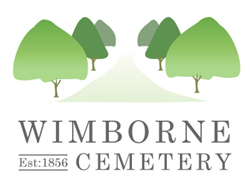The Metropolitan Burials Act 1852 (15 & 16 Vic c.85) was the first adoptive act which encouraged municipal burials. Its success was such that it was soon followed by the Burials (Beyond the Metropolis) Act 1853 (16 & 17 Vic c.134).
It was this latter act which was adopted by Wimborne Minster vestry in October 1854 to provide for a Burial Board which would administer burials within the ecclesiastical parish of Wimborne Minster. The purchase of the original site in 1855, was from Henry Castleman costing £658.15 shillings for 4 acres and 36 poles and was then commonly known as ‘Culverhays’. The deed states the land is to be used solely for the purpose of burial and in 1855 work began on building the Lodge and Chapels. The cemetery opened on 1st April 1856 when the first interment took place of a two-year-old child, Walter Noah Cull of the union workhouse in Wimborne.
From the Lodge and archway at the bottom of the hill, the land to the left of the pathway is consecrated Church of England ground and the Chapel to the left of the pathway was built for ‘conformists’ to hold funeral services; it was believed at that time, that the closer you were buried to the Chapel, the closer you were to God and would have been kept for prominent figures in society or those who could afford the premium. The land to the right is mostly unconsecrated ground and the mirror building of the Chapel held services for ‘non-conformists’ which allowed followers of another or no faith, to hold funerals within the grounds.
In 1868 the small section of road running from Victoria Road to Cemetery Lodge was purchased. Prior to this, access to the Cemetery had always been from Culverhays Road. This section of road cost £31.17 shillings and 6 pence and was purchased from John Floyer of West Stafford and Charles Wrothesley Digby – the full length of road runs from St Margaret’s Hill to Stone Lane and is now known as Cemetery Road.
The re-organisation after the Local Government Act 1894 meant that for the purpose of local government administration Wimborne Minster parish became part of Wimborne urban District Council, Colehill Parish Council, Holt Parish Council and Pamphill Parish Council. As vestry powers passed to these new bodies the Burial Board was superseded by the Wimborne Burials Joint Committee, which included representatives from each council. The first meeting of this committee was in March 1895. Holt Parish Council voted to leave this arrangement in October 1900 and officially left the Joint Committee on 31st March 1902; Holt’s own chapel burial ground had been extended in the late nineteenth century.
Further acquisitions of land took place in 1904 when the area behind the original site running up to Stone Lane was purchased. This was an area of 2.18 acres costing £322.10 shillings from Walter Ralph Bankes. And again in 1942 the land now situated in the middle of the top area was purchased from Henry John ‘Ralph’ Bankes at a cost of £400. Later, in 1978 the Committee acquired a further 3.87 acres of land at the corner of Stone Lane and St Margaret’s Hill from ‘Ralph’ Bankes. This area cost £5,900 and is known as the extension land which now forms the new garden of remembrance known as Stone Lane Garden where the first interment took place on 1st March 2004, as well as providing for 22 allotments.
Today the site of Wimborne Cemetery sits on 12.56 acres of land comprised mostly of burial space and is estimated to have around 20-25 years of useable burial space remaining. The Lodge next to the archway is used as private residence and while the Chapel to the left of the main pathway is still used for funeral services and the one to right is now a workshop. The Joint Committee was renamed the Wimborne Cemetery Joint Management Committee in the 1980’s. As of the 31st of March 2024, Wimborne Cemetery Joint Management Committee have dissolved and Wimborne Cemetery is now owned and managed by Wimborne Minster Town Council.
